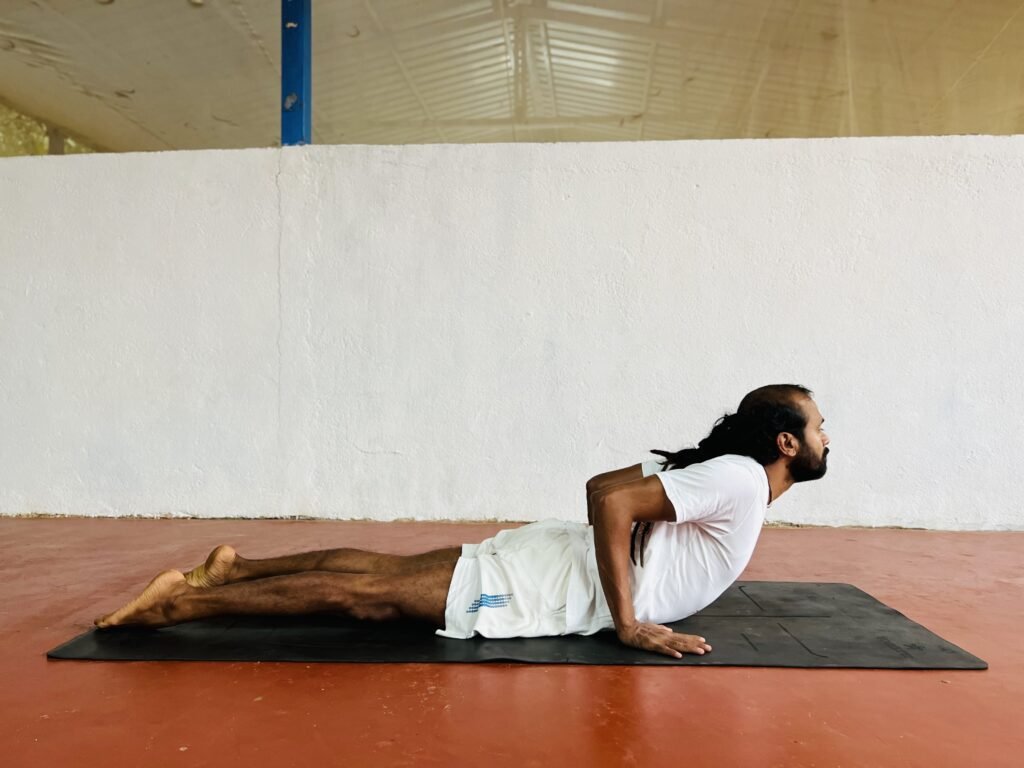
The sphinx pose is a basic backbend in which the body resembles a mythical sphinx, the half-lion creature portrayed in Egyptian statues and pyramids. This beginner’s version of the cobra pose has you lying on your stomach, supporting your weight with your forearms as you bend your back slightly.
Salamba Bhujangasana, also known as “supported cobra pose,” is a combination of the words “supported” (Salamba) and “cobra” (Bhujanga), the ancient Indian language from which yoga originated (asana).
“Sa” denotes “with,” and “Alamba” indicates “support.” “Bhujanga,” which translates to “cobra” or “serpent.” “Asana,” which means “pose,” Your forearms, which assist in lifting your upper body in the pose, are the “support.” Because of how closely this pose resembles the mythical, half-lion creatures immortalized in ancient Egyptian statues, it is more frequently referred to as the “Sphinx Pose.”
At the beginner level, students are introduced to Salamba Bhujangasana (Sphinx Pose), a mild backbend pose component of prone poses. As part of the backbend yoga sequence, the Sphinx Pose is easy on the lower back and helps to open the chest, acting as a heart opener.
After a long day at work, the Sphinx Pose is a lovely way to lengthen and strengthen the back. As a result, if you only have five minutes at the end of the night, press up onto your forearms and let the pose do what it does best.
Step-by-Step Instructions for the Sphinx Pose
- Lie on your stomach with your legs crossed. Your tailbone should be lengthened toward your heels and firmed toward your pubis. Then, roll your outer thighs toward the floor to rotate your thighs inward. Your lower back and sacrum, the downward-facing triangular bone at the back of your pelvis, are widened and lengthened. As a result, protecting them from injury during a backbend.
- Actively touch the wall behind you with your toes. Keep lengthening your tail toward your heels to protect your lower back as you strike the pose. You should have firm but not clenched buttocks. Your tongue, eyes, and brain should be silent while your legs move.
- Set your forearms parallel to the ground and place your elbows under your shoulders at this point. Take a deep breath and bend your back slightly by lifting your upper torso and head off the floor.
- Bringing awareness to your lower belly, the region just above the pubic bone and below the navel is the last step to establishing a solid foundation in Sphinx Pose.
- Draw it away from the floor just enough to form a dome that curves up toward your lower back. There is no need for rigidity, hardening, or sucking in; this is very subtle. By supporting and distributing your backbend’s curve along the length of your spine more evenly, this belly lift will calm your lower back and awaken your upper back.
- After remaining for five to ten breaths, slowly release your belly with an exhale before lowering your head and torso to the ground. Shift your gaze to the side.
- Spend time lying quietly while expanding your back with each inhalation and letting go of any tension with each exhalation. If you like, repeat it once or twice more.
SPHINX POSE BENEFITS
Stretches and Strengthens:
Salamba Bhujangasana (Sphinx Pose) practice stretches the arms, chest, shoulders, abdominal muscles, and neck and stretches the entire back, particularly the muscles of the spine. Stretching exercises help strengthen the arms, back, spine, and gluteus muscles (buttocks). The tightening of these muscles supports the hips, spine, and pelvis.
Blood Circulation and Nervous System:
This pose, which acts as a backbend, is beneficial for raising blood oxygen levels, and improving blood circulation. Back muscles are stretched, activating joints like the hips, pelvic girdle, spine, rib cage, shoulders, elbows, neck, etc., improving nerve function. By doing so, the nervous system is kept active and under control.
Posture and Toning:
Salamba Bhujangasana (Sphinx Pose), when practiced for a longer period while focusing on slow, deep breathing, helps to improve spinal posture while preserving the natural curves of the spine. Those with hunched back benefit from maintaining the natural curve of their upper and lower backs. Stretching out the arms, shoulders, chest, abdomen, and pelvis keeps the body in shape and the muscles in those areas strong. Sphinx Pose is beneficial for students experiencing back or neck pain, which can affect any part of the spine. When practiced under the direction of a yoga teacher, it aids in the therapeutic relief of back and neck pain.
Internal Organs and Massage:
Stretching the chest and abdomen helps activate the adrenal glands, which gently massage and stimulate the kidneys. The gentle stretching of the upper abdominal region also stimulates the digestive system. With better breathing comes a conscious increase in lung capacity, thanks to chest stretching.
Stress and exhaustion:
Sphinx Pose is a simple therapeutic pose that keeps stress and anxiety at bay because it gently stretches the hips and psoas muscles while opening the lower back. As part of nighttime yoga, this is a fantastic exercise to help with easing body fatigue and tiredness before bed.
Contraindications to Sphinx Pose:
Injury or Stiffness:
While this pose is good for back pain, if students have an injury in any part of the spine or stiff back, they should take it slow or, better still, avoid it. since it will be challenging to enter and exit the pose. Stiffness of the neck, back, shoulders or hips can be reduced when it is done with support, like in Bhujangasana With Bolster Under Elbows (Sphinx Pose With Bolster Under Elbows).
Women:
Pregnant women should avoid this pose since there would be pressure in the abdominal area during this backbend.
Spondylitis:
Students who have issues related to their neck or have spondylitis should keep the neck relaxed and even look down, keeping the chin close to the chest. At any time, if there is any discomfort, students should discontinue the practice.
